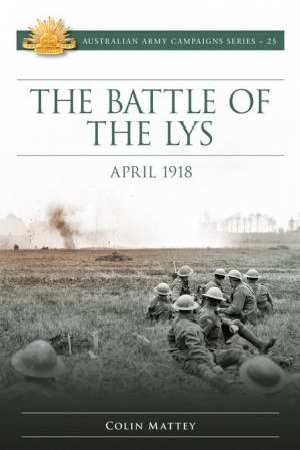In April 1918 Ludendorf’s Operation Georgette was smashing its way to the critical British railhead of Hazebrouck. The fall of Hazebrouck would push the BEF down their supply lines to the Channel ports and threaten to knock Britain out of the war. Into this pivotal moment of military and European history strode the 1st Australian Division.

Paperback 160pp RRP $19.99
Lys is the twenty-fifth instalment of the Army History Unit’s excellent Australian Army Campaigns Series, covering the period 11-29 April 1918 that saw the 1st Australian Division maintain a hastily organised defence of the British Expeditionary Force’s (BEF) northerly logistics hub of Hazebrouck. This was the month of Germany’s ‘Spring Offensive’, the last opportunity for the victorious German divisions from the old Eastern Front now transferred west to provide Germany with numerical superiority before the weight of American arms became overwhelming.
At the start of the 1918 campaign season, with the bulk of the American Army still training in home bases and the French Army exhausted and unreliable with outbreaks of mutiny, the key to German success was clear; Britain was the only Allied power capable of offensive action: force the BEF to the sea and the war would be won.
As Mattey carefully explains, a key strength of the BEF by 1918 was its logistical support. Under the guidance of civilian railway engineer, Sir Eric Geddes, French ports along her Channel and North Atlantic coasts hummed with the unloading of British tonnage that fed two supply lines culminating at the railheads of Amiens in the south and Hazebrouck in the north. Without these logistical hubs the forward position of the BEF could not be maintained and any possibility of a large-scale Allied offensive would be lost.
Amiens was the first of these centres to receive German attention, Operation Michael being launched on 21 March and Operation Mars a week later. Early German success meant enemy shells were reaching Amiens by late March, but the work of Gedde’s logistical machine continued uninterrupted.
The defence of Amiens held and on 5 April, Ludendorf ‘paused’ Operation Michael.
Operation Georgette, intended to maintain the offensive, was launched four days later, on 9 April in the northerly Flanders sector of the line supplied by Hazebrouck. Meanwhile, the 1st Australian Division had just been transferred from the previously quiet Flanders sector arriving in Amiens on 6 April. On 10 April Divisional headquarters received orders to entrain back to Flanders. By 11 April, the first men of the 1st Australian Division, just five days after leaving, were arriving back in Hazebrouck.
By this time the threat to Hazebrouck was acute, 11 April 1918 is the day of Haig’s famous “with our backs to the wall” Special Order of the day. As the men detrained, rather than concentrating in Hazebrouck, they were immediately moved up the line, battalion by battalion. In front of the 1st Division were BEF units that had been working since 9 April to slow the pace of Operation Georgette, but they were now in the parlance of the time, ‘in the blue’; that is their precise position was unknown and were most likely withdrawing.
The book’s excellent photographs, reproduced from the AWM archive, show the flimsy barricades the Division were able to erect south-west of Hazebrouck. As those British units that had spent themselves slowing the German advance reached Australian lines it became clear, if there had ever been any doubt, that the defence of Hazebrouck was now in the hands of the 1st Australian Division. As Lieutenant Joynt recalled later, ‘The situation was critical – we had the notion, “By Cripes we’re going to be licked. It’s on us”’.
The German onslaught began in earnest on 14 April. To the hastily dug-in Australians, the large German infantry formations were daunting. But in one key respect Operation Georgette was different to the earlier Operation Michael. The stormtrooper tactics and carefully choreographed artillery bombardments that had brought the German Army so close to Amiens were largely absent at Hazebrouck. To Corporal Turvey operating a Lewis machine gun from the Australian lines it was ‘like firing into a haystack, one could not miss’. Allied artillery was able to disrupt German formations, which, being far advanced and lacking the same logistical support, were only a limited German response.
German attacks continued for the next three days, with the partial success of seizing the village of Meteren, but the Australian line held and the threat to Hazebrouck was averted. Attempts to retake Meteren were not as successful, with the coordination of combined arms that had been so effective in defence proving less so in attack. Both lines consolidated their positions. Ludendorf officially cancelled Operation Georgette on 1 May, a senior member of the German staff noting that ‘no great strategic movement had become possible… the second great offensive [Operation Georgette] had not brought about the hoped-for decision’.
The wave of the last great German advance had crashed and broken and as spring became summer, with the BEF’s supply lines still intact (thanks in large part to the 1st Australian Division), the American Expeditionary Force (AEF) beginning to arrive in Europe and morale returning to a buoyed French Army, the scene was now set for the war’s final act.
Mattey’s book successfully takes the reader from Allied and German grand strategy in early-1918 to what these plans meant for the one division that was to play a crucial role in disrupting Ludendorf’s plan for German victory in spring 1918. Boxes that detail the technicalities of equipment used by both sides will be useful to those less familiar with the armaments of the time, and the accompanying maps add to the clearly presented tactical detail of the text. A map overlaid with the same letter-number grid that was used in Divisional communication at the time might be a useful addition to new editions.
Reviewed fro RUSIV by Richard Batley, June 2019
Contact Royal United Services Institute about this article.






